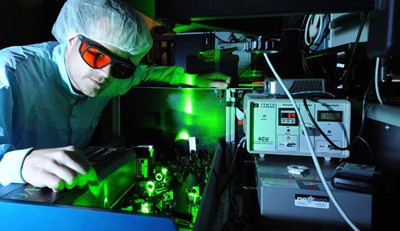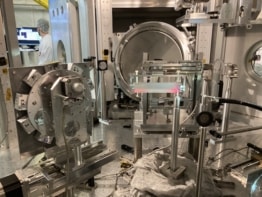
Physicists in Germany say they have taken an important step towards the creation of ultrafast computers that use light instead of electrical signals to process information. The team has created the first compact electronic device that can measure the absolute phase of extremely short light pulses. While the device is first expected to find use in laser labs, it could someday play an important role in systems that use ultrashort light pulses to process information.
The work was done by Ferenc Krausz and colleagues of the Max Planck Institute of Quantum Optics in Garching. In 2001 a team led by Krausz and colleagues generated and measured the first isolated light pulse lasting only attoseconds – just a billionth of a billionth of a second. Such pulses have since been used to study the motion of electrons inside atoms and they form the basis of the new and burgeoning field of “attosecond physics”.
While the technology used to create and characterize these pulses has improved over the past decade, it still involves the use of large and expensive pieces of equipment. This includes the techniques used to make absolute phase measurements, which are essential for understanding rapidly varying optical signals. Although there are many techniques for sensing relative changes in light phase, measuring its absolute value (relative to a standard) is a challenge for visible-light pulses. Currently, there are techniques available – attosecond streaking and stereo above threshold ionization (ATI) – but both methods require high-vacuum conditions and large amounts of physical space, making them unsuitable for deployment on a tiny device.
Insulator to conductor
The new work builds on research done in 2013, when the team showed that light can quickly turn an electrical insulator into an electrical conductor. When a metal–dielectric–metal junction was exposed to an extremely short pulse of intense light, the team was able to measure a current flowing through the electrodes. The researchers found that the strength and direction of the current could be controlled by altering the waveform of the pulse.
Now, the scientists have created a device that uses this effect to measure the absolute phase of very short pulses. The phase of a pulse is determined by using the device to track the sinusoidal variation of the electric field of light, which drives an oscillating current in the device at petahertz (1015) frequencies. “This raised the exciting prospect of using these exceedingly fast currents to actually measure optical fields through a direct electronic readout,” says team member Nicholas Karpowicz, also of the Max Planck Institute of Quantum Optics. The result is a device that can take rapid “snapshots” of the shape of the oscillating light field.
Femtosecond pulses
The measurements were made on light pulses lasting about a femtosecond (10−15). These pulses are used to generate attosecond (10−18) pulses in a process that requires precise knowledge of the absolute phase of the original femtosecond pulses.
One advantage of the detector is that it is more compact than the existing ones and does not need to be in vacuum. “[It is] easy to imagine it becoming a commercial device – a little black box – that other research groups can buy and use to measure the [light phase] from their lasers,” says John Tisch of Imperial College London, who did not take part in the research.
Others, however, point out that our understanding of the effect is still in its infancy. “The universal applicability and transferability of this observation to other dielectric materials or geometries is not yet known,” says Joachim Burgdörfer of the Institute for Theoretical Physics, Vienna University of Technology in Austria, who was not involved in the study.
More research needed
In principle, the device could be used to convert information encoded in light pulses into electronic data. “This may lead to the ability of processing signals at rates tens of thousands of times higher than today’s digital electronics are able to do – potentially increasing computing power by about the same factor, in the long run,” says Krausz. However, he cautions that it may take a very long time for this to happen, if at all. Indeed, speeding up electronics will require much more than just light-phase measurements. Another important challenge facing anyone wanting to create high-speed circuits is finding a way of essentially running the interaction in reverse. That is to cause the light field to change in response to electrical changes in the device: and for this to happen on the same extremely short timescale.
Although there is still some way to go before light-wave gadgets appear on the market, the research is “definitely a stepping-stone on the way” says Tisch. “In the future, such devices might be viewed in the same light as the first transistors from the 1940s, which though groundbreaking in their time, by today’s standards look like a school science-fair project,” he adds.
The device is described in Nature Photonics.
- You can learn more about attosecond physics by watching the video below.


